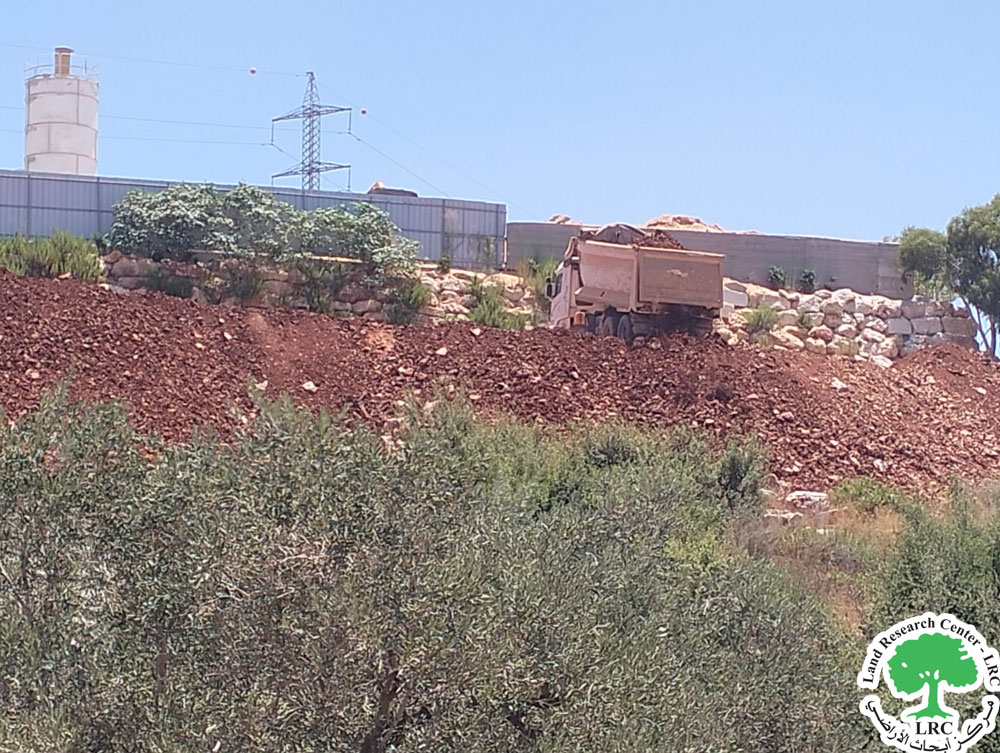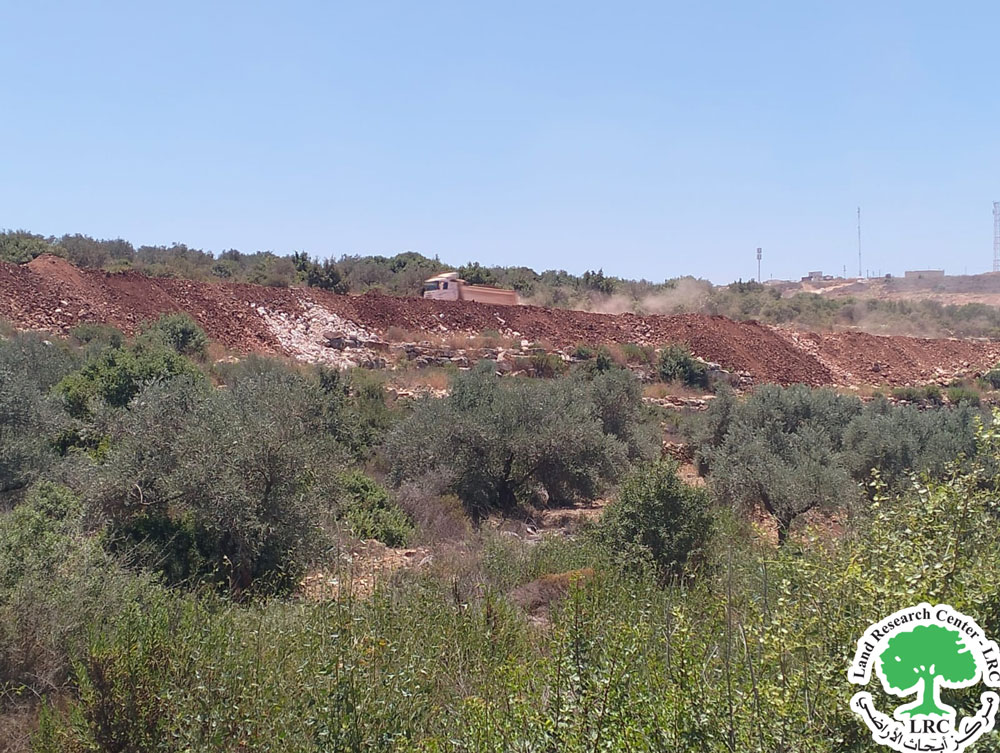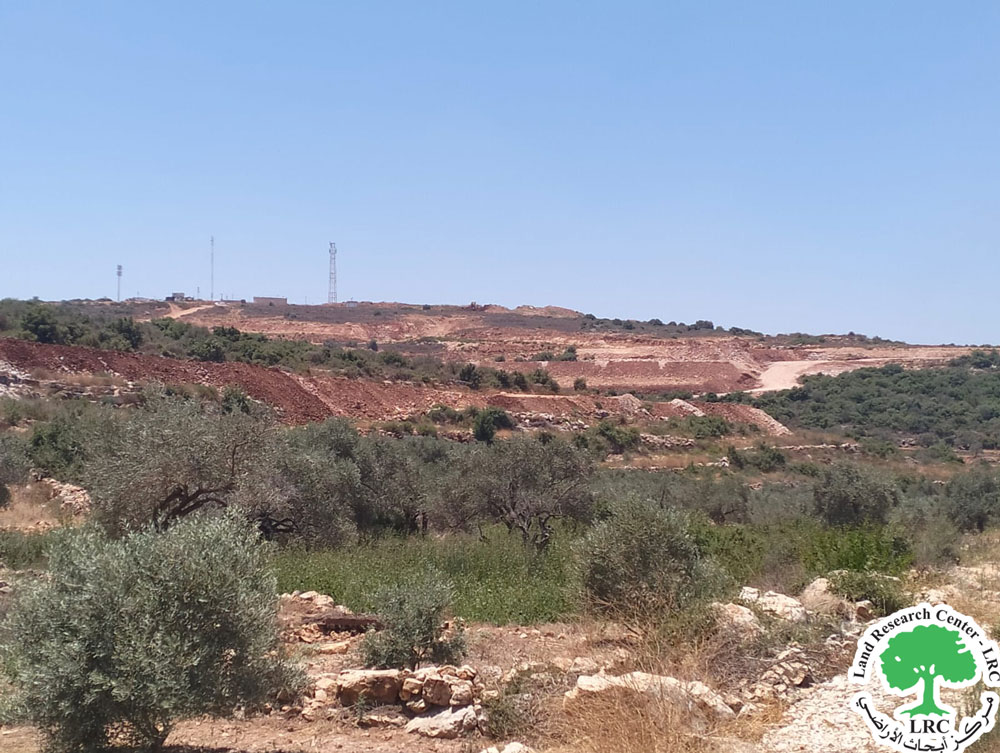Occupation Continues to Bulldoze Land in "Jabal al-Dib" Area East of Jinsafut Village, Qalqilya Governorate
- Violation: Bulldozing of agricultural lands to expand a colonial industrial zone.
- Location: Jinasafut Village / Qalqilya Governorate.
- Date of Violation: July 2024.
- Perpetrator: "Emmanuel" Industrial Settlement.
- Affected Party: The Bashir Family.
- Details of the Violation: Occupation machinery continues to bulldoze extensive areas of agricultural lands in the "Jabal al-Dib" area, located southeast of Jinajafut village. According to field monitoring at the site of the violation, approximately 209 dunums of land, owned by farmers from Jinasafut village and confirmed through financial documents proving their ancestral connection to the land, have been bulldozed up.
The bulldozed lands fall within the natural basin No. (1), Plot No. (18) in the Jabal al-Dib area and the Wadi al-Qat site of the village's lands. The settlers are bulldozing these agricultural plots to expand the area occupied by the "Emmanuel" industrial settlement.
 |  |  |
From the bulldozing of citizens' lands in Jinajafut
The ownership of the bulldozed lands belongs to:
The Affected Farmer | Family Member |
Area of land affected | ||
male | female | children | ||
Heirs of the deceased Yousef Ali Hasan Bashir | 23 | 31 | 11 | 23 |
Heirs of the deceased Abdullah Mahmoud Ahmad Bashir | 29 | 22 | 13 | 29 |
Heirs of the deceased Abdulrahim Ali Hasan Bashir | 31 | 24 | 15 | 38 |
Murad Mohammad Hasan Bashir | 4 | 3 | 1 | 122 |
Total | 40 | 80 | 87 | 209 |
Affected Farmer Hassan Bashir Informs the Land Research Center:
"The lands being bulldozed are owned by our family, and we have been farming them for generations. We previously planted olive trees and almonds, but the trees were completely uprooted by the occupation in past years. Despite this, we replanted the land again. Recently, we were shocked to see the occupation carry out extensive bulldozing in the area, leveling all the lands. They even dumped the earth onto neighboring lands, which are also completely threatened due to the occupation's actions."
He added:
"We filed an official complaint with the Palestinian Coordination Office, which forwarded the complaint to the occupation police, but there has been no progress so far. We hope that a human rights organization will fully adopt the issue and help resolve the farmers' problem."
Farmer Taysir Bashir believes that what is happening is a total destruction of agricultural lands. He stated:
"What is happening is a real challenge for us. The wastewater from the 'Emmanuel' settlement has damaged a large portion of our lands, rendering them unsuitable for use. I lost more than 12 trees on my land due to the wastewater, and now the same settlers are bulldozing part of my land and burying another part with earth, affecting more than four dunums. This will result in losing my land entirely, leaving me with nothing."
It is worth mentioning that the Jabal al-Dib area is adjacent to the 'Emmanuel' industrial area, where the occupation is attempting to expand the industrial zone at the expense of the farmers there.
Jinasafut Village:
Located 17 km southeast of Qalqilya city, Jinahafut covers an area of 8,659 dunums, of which 218 dunums are built-up. The population was approximately 2,571 as of 2017. The village has been a victim of Israeli settlements, with about 688 dunums taken: 538 dunums for the 'Nofei Uranim' settlement and 150 dunums for the 'Karnei Shomron' settlement.
Expansion of Colonial Industrial Area at the Expense of Agricultural Lands – Another Threat to the Palestinian Environment:
The threat to the Palestinian environment continues due to Israeli occupation practices through various means. One of the prominent environmental violations is the ongoing construction of new settlements or the expansion of existing ones on Palestinian agricultural lands. The construction of a settlement or any new expansion means additional environmental pollution. The environmental pollution caused by Israeli settlements and factories, including wastewater and the destruction and bulldozing of agricultural and pastoral lands, converting them into settlement areas, has severely impacted biodiversity in Palestine. Bulldozing for settlements and constructing bypass roads results in the removal of green spaces, plants, trees, and large areas of forests, leading to the disappearance of many plant species and preventing their regrowth in the same area.
Bulldozing activities have also led to the removal and destruction of wildlife habitats, forcing animals to flee and migrate to other areas, creating a state of environmental fragmentation in Palestine. Furthermore, the effects of other environmental pollutants have impacted plant growth, insect reproduction, and the spread of diseases that affect wildlife. The major issue is the depletion of Palestinian water resources, leading to reduced water availability and affecting plant and tree growth.
مشروع: حماية الحقوق البيئية الفلسطينية في مناطق "ج" SPERAC IV - GFFO
Disclaimer: The views and opinions expressed in this report are those of Land Research Center and do not necessarily reflect the views or positions of the project donor; the Norwegian Refugee Council.
إخلاء المسؤولية: الآراء ووجهات النظر الواردة في هذا التقرير هي آراء ووجهات نظر مركز أبحاث الأراضي ولا تعكس بالضرورة وجهات نظر أو مواقف الجهة المانحة للمشروع؛ المجلس النرويجي. للاجئين

